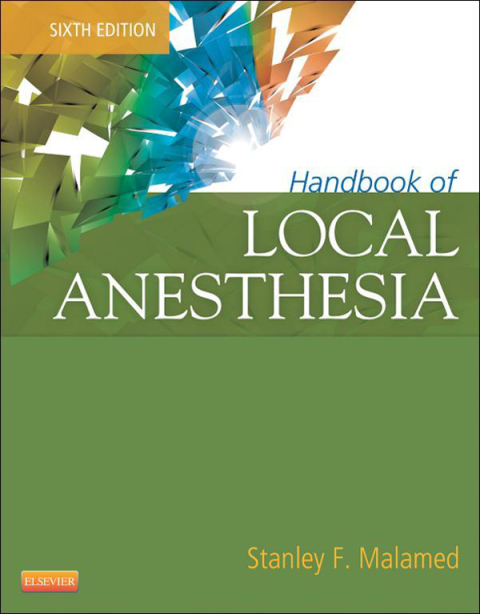Description
Efnisyfirlit
- Cover image
- Title page
- IFC
- Copyright
- Dedication
- Contributors
- Preface
- Acknowledgments
- New to this Edition
- DVD Supplement
- New Information
- New Illustrations Identify Clinically Important Anatomy
- Part I: The Drugs
- Introduction
- Chapter 1. Neurophysiology
- Desirable Properties of Local Anesthetics
- Fundamentals of Impulse Generation and Transmission
- Mode and Site of Action of Local Anesthetics
- Active Forms of Local Anesthetics
- Kinetics of Local Anesthetic Onset And Duration of Action
- References
- Chapter 2. Pharmacology of Local Anesthetics
- Pharmacokinetics of Local Anesthetics
- Systemic Actions of Local Anesthetics
- References
- Chapter 3. Pharmacology of Vasoconstrictors
- Chemical Structure
- Modes of Action
- Dilutions of Vasoconstrictors
- Pharmacology of Specific Agents
- Selection of a Vasoconstrictor
- References
- Chapter 4. Clinical Action of Specific Agents
- Selection Of A Local Anesthetic
- Duration
- Maximum Doses of Local Anesthetics
- Ester-Type Local Anesthetics
- Amide-Type Local Anesthetics
- Anesthetics For Topical Application
- Selection Of A Local Anesthetic
- References
- Part II: The Armamentarium
- Introduction
- Chapter 5. The Syringe
- Types of Syringes
- Care And Handling of Syringes
- Problems
- Recommendations
- References
- Chapter 6. The Needle
- Types
- Anatomy of A Needle
- Gauge
- Length
- Care And Handling of Needles
- Problems With Needles
- Recommendations
- References
- Chapter 7. The Cartridge
- Components
- Cartridge Contents
- Care And Handling
- Problems
- Recommendations
- References
- Chapter 8. Additional Armamentarium
- Topical Antiseptic
- Topical Anesthetic
- Applicator Sticks
- Cotton Gauze
- Hemostat
- References
- Chapter 9. Preparation of the Armamentarium
- Breech-Loading, Metallic Or Plastic, Cartridge-Type Syringe
- Placing An Additional Cartridge In A (Traditional) Syringe
- Self-Aspirating Syringe
- Ultrasafe Aspirating Syringe
- Part III: Techniques of Regional Anesthesia in Dentistry
- Introduction
- References
- Chapter 10. Physical and Psychological Evaluation
- Goals of Physical and Psychological Evaluation
- Physical Evaluation
- I Circle Appropriate Answer: (Leave blank if you do not understand the question.)
- II Have You Experienced
- III Do You Have or Have You Had
- IV Do You Have or Have You Had
- V Are You Taking
- VI Women Only
- VII All Patients
- Physical Examination
- Physical Status Classification System
- Drug–Drug Interactions and Contraindications
- Malignant Hyperthermia
- Atypical Plasma Cholinesterase
- Methemoglobinemia
- References
- Chapter 11. Basic Injection Technique
- ♦ Step 1
- ♦ Step 2
- ♦ Step 3
- ♦ Step 4
- ♦ Step 5
- ♦ Step 6
- ♦ Step 7A
- ♦ Step 7B
- ♦ Step 8
- ♦ Step 9
- ♦ Step 10
- ♦ Step 11A
- ♦ Step 11B
- ♦ Step 12
- ♦ Step 13
- ♦ Step 14
- ♦ Step 15
- ♦ Step 16A
- ♦ Step 16B
- ♦ Step 17
- ♦ Step 18
- ♦ Step 19
- References
- Chapter 12. Anatomic Considerations
- Trigeminal Nerve
- Osteology: Maxilla
- Osteology: Mandible
- References
- Chapter 13. Techniques of Maxillary Anesthesia
- ♦ Local Infiltration
- ♦ Field Block
- ♦ Nerve Block
- ♦ Discussion
- Maxillary Injection Techniques
- Teeth And Buccal Soft And Hard Tissues
- Palatal Anesthesia
- Summary
- References
- Chapter 14. Techniques of Mandibular Anesthesia
- Inferior Alveolar Nerve Block
- Buccal Nerve Block
- Mandibular Nerve Block: The Gow-Gates Technique
- Vazirani-Akinosi Closed-Mouth Mandibular Block
- Mental Nerve Block
- Incisive Nerve Block
- References
- Chapter 15. Supplemental Injection Techniques
- Intraosseous Anesthesia
- Intrapulpal Injection
- Mandibular Infiltration in Adults
- Summary and Conclusions
- References
- Chapter 16. Anesthetic Considerations in Dental Specialties
- Endodontics
- Pediatric Dentistry
- Periodontics
- Oral and Maxillofacial Surgery
- Fixed Prosthodontics
- Long-Duration Local Anesthesia
- Dental Hygiene
- References
- Part IV: Complications, Legal Considerations, Questions, and Future
- Introduction
- Chapter 17. Local Complications
- Needle Breakage
- Prolonged Anesthesia or Paresthesia
- Facial Nerve Paralysis
- Trismus
- Soft Tissue Injury
- Hematoma
- Pain on Injection
- Burning on Injection
- Infection
- Edema
- Sloughing of Tissues
- Postanesthetic Intraoral Lesions
- References
- Chapter 18. Systemic Complications
- Classification of Adverse Drug Reactions
- Overdose
- Allergy
- Summary
- References
- Chapter 19. Legal Considerations
- Duty
- Standard of Care
- Proximate Cause
- Damage
- Consent
- Health Insurance Portability and Accountability Act of 1996
- Third Parties
- Overdose
- Allergy
- Instruments
- Alternative Delivery Systems/Techniques
- Local Reactions to Local Anesthetic Administration
- Lip Chewing
- Subcutaneous Emphysema
- Vascular Penetration
- Neural Penetration
- Chemical Nerve Injury
- Local Anesthetic Drug Interactions
- Psychogenic Reactions
- Postprocedure Evaluation
- Respondeat Superior
- Statute Violation
- If Malpractice Exists
- Conclusion
- Selected Bibliography
- Chapter 20. Future Trends in Pain Control
- Buffered Local Anesthetics (The local anesthetic “on” switch)
- Phentolamine Mesylate (The local anesthetic “off” switch)
- How Local Anesthetics Work—An Overview
- Articaine HCL by Buccal Infiltration in the Adult Mandible
- Intranasal Local Anesthesia
- Computer-Controlled Local Anesthetic Delivery (C-Clad)
- References
- Chapter 21. Questions
- Local Anesthetics
- Vasoconstrictors
- Syringes
- Needles
- Cartridges
- Techniques of Regional Anesthesia in Dentistry
- References
- Index
- IBC






Reviews
There are no reviews yet.